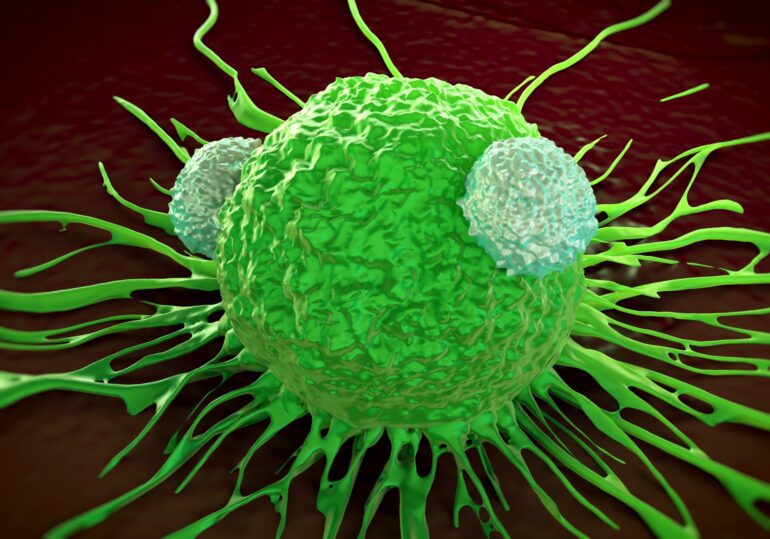TL;DR:
- Fusion oncoproteins, a key driver in 15% of cancers, form by combining segments of two different proteins due to DNA rearrangements.
- St. Jude’s research unveils fusion oncoproteins’ propensity to create condensates in cells, contributing to cancer development.
- A painstaking manual examination of 166 fusion oncoproteins reveals that 58% can form condensates, impacting gene regulation and cell signaling.
- Machine learning identifies distinct physicochemical patterns in condensate-forming fusion oncoproteins sequences.
- The algorithm predicts that around 67% of 3,000 fusion oncoproteins associated with cancer types can form condensates, with an 80% accuracy rate in testing.
- This research lays the groundwork for targeted therapies against fusion oncoprotein-driven cancers.
Main AI News:
In the ever-evolving landscape of cancer research, breakthroughs continue to shed light on the intricacies of the disease. One such revelation revolves around fusion oncoproteins, enigmatic molecules formed when DNA rearrangements bring together segments of two different proteins. These fusion oncoproteins possess the potential to wreak havoc within our cells, promoting uncontrolled cell division and the onset of cancer.
A groundbreaking study conducted by St. Jude Children’s Research Hospital has not only unraveled the mysteries surrounding fusion oncoproteins but has also harnessed the power of machine learning to predict their behavior. Published in the prestigious pages of Nature Communications, this research offers profound insights into cancer development.
The Unveiling of Fusion Oncoprotein Secrets
Richard Kriwacki, Ph.D., from the St. Jude Department of Structural Biology, leads the charge in this endeavor. He and his collaborators hypothesized that the ability of fusion oncoproteins to form condensates within cells might be intricately linked to their oncogenic properties. These biomolecular condensates arise through a process known as liquid-liquid phase separation, creating distinct compartments within the cell, akin to oil droplets in water. While condensates play a crucial role in regulating various cellular processes, fusion oncoproteins with this capability can spell disaster.
Cracking the Code of Condensate Behavior
The research team embarked on an extensive examination of 166 fusion oncoproteins within cells, meticulously categorizing their phase separation patterns. Hazheen Shirnekhi, Ph.D., one of the co-first authors from the St. Jude Department of Structural Biology, attested to the challenges faced during this process. “The condensates exhibited diverse sizes, shapes, and cellular locations,” Shirnekhi remarked. “Recognizing these condensates in an unbiased manner required manual effort, consuming a significant amount of time.“
Their dedication yielded a crucial finding: 58% of the examined fusion oncoproteins were capable of forming condensates, opening new doors to understanding their behavior.
Machine Learning: A Catalyst for Discovery
Not stopping at the observation of cellular functions, the research team began noticing patterns within the protein sequences of condensate-forming fusion oncoproteins. These patterns were linked to physicochemical features, such as the presence of polar amino acids, charged groups, or disordered regions.
Swarnendu Tripathi, Ph.D., another co-first author from the St. Jude Department of Structural Biology, explained, “Distinct features emerged in the sequences of condensate-forming fusion oncoproteins compared to their non-condensate-forming counterparts. This led us to select 25 non-redundant features and employ data science techniques to predict condensate-forming behavior.”
The researchers used their groundwork on 166 samples to train a machine-learning algorithm, which was subsequently applied to predict the behavior of approximately 3,000 additional fusion oncoproteins associated with various cancer types. Remarkably, the model forecasted that a staggering 67% of these fusion oncoproteins were likely to form condensates. Subsequent testing validated the model’s accuracy, achieving an impressive 80% in independent trials.
Paving the Way for Targeted Therapies
This research establishes a foundational framework for unraveling the mechanisms underpinning the oncogenic potential of fusion oncoproteins. The ultimate goal? To enable the development of targeted interventions, whether through pharmaceutical agents or innovative alternatives. As Kriwacki emphasizes, “By delving into the underlying mechanisms, we are setting the stage for potential groundbreaking therapeutic strategies against fusion oncoprotein-driven cancers.”
Conclusion:
This groundbreaking research not only sheds light on the complex behavior of fusion oncoproteins but also demonstrates the immense potential of machine learning in cancer research. The ability to predict condensate formation in fusion oncoproteins offers new avenues for developing targeted therapies, presenting significant opportunities for pharmaceutical companies and healthcare providers in the ever-evolving cancer treatment market.

